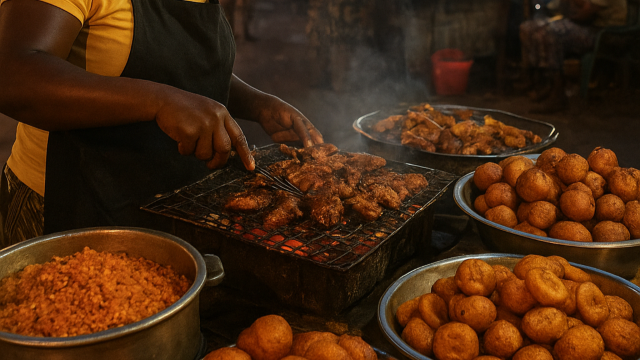On a humid evening in Accra, smoke from roadside grills drifts above the traffic, mingling with the scent of ginger and chili. The city’s street food scene is not just sustenance but spectacle, a living archive of flavors that carry stories of history, migration, and celebration. To eat in Accra is to step into a rhythm that pulses as strongly through its markets as through its music.
At the heart of this tradition is jollof rice, a dish layered with tomatoes, onions, and spices, its fragrance a familiar presence at both roadside stalls and family gatherings. Vendors ladle it onto plates with fried plantains or grilled chicken, each portion carrying the warmth of a recipe passed through generations. For many Ghanaians, jollof is more than a staple—it is the centerpiece of weddings, parties, and neighborhood festivities, a reminder of how food can shape identity as much as it satisfies hunger.
Elsewhere, the golden cubes of kelewele—spiced plantains fried in oil—crackle in cast-iron pans. Seasoned with ginger and pepper, sometimes laced with cloves or peanuts, they are eaten late into the night by crowds gathered at street corners. Light but fiery, the dish speaks to Ghana’s long-standing love of heat in food, a culinary constant across regions.
The coastal neighborhoods, particularly Osu, are where fish takes center stage. Charcoal fires roast tilapia and mackerel until their skins crisp, while vendors ladle out shito, a smoky, pepper-based sauce made with dried shrimp or fish powder. It is food designed for the open air: hearty, communal, inseparable from the din of conversation and the jostle of the crowd.
Chinchinga—grilled meat skewers dusted with paprika and cayenne—sizzles on racks nearby. Often sold from small carts, these kebabs are a staple of Accra’s nightlife. Served with onions and a dollop of shito, they provide quick energy for the long hours when music and conversation stretch past midnight.
For those seeking sweetness, vendors pull freshly fried bofrot from bubbling oil. These round doughnuts, coated lightly with sugar, are typically enjoyed with tea or cocoa at dawn. Their simplicity belies a cultural weight: like much of Accra’s street fare, they are as tied to social life as they are to appetite.
What lingers, beyond the taste, is the human exchange. Food stalls double as gathering points, where vendors call out to familiar customers and strangers alike. Transactions are punctuated with laughter and long conversations, offering glimpses of the communal spirit that defines the city as much as any monument or museum.
Accra’s street food is not a trend but a tradition, sustained by generations who have made the city’s pavements a stage for Ghanaian hospitality. To eat here is to encounter the ingenuity of everyday cooks, the endurance of recipes shaped by history, and the intimacy of a meal shared in public. It is food that insists on being remembered, long after the last bite.
Sources:
- Ghana Tourism Authority, Street Food and Culinary Heritage in Ghana (official publication)
- Brillat, Colette. African Street Food Cultures. Routledge, 2019.
- National Commission on Culture, Ghana, Culinary Practices and Traditions Report
- Osseo-Asare, Fran. Food Culture in Sub-Saharan Africa. Greenwood Press, 2005


